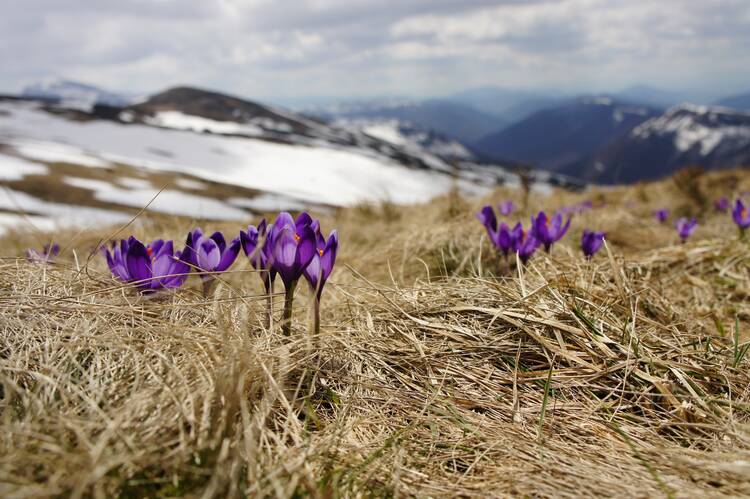A Homily for the Fifth Sunday of Lent
Readings: Ezekiel 37:12-14 Romans 8:8-11 John 11:1-45
What do you see when you look out the window? That depends on the window, does it not? In like measure, what we know—and how we know what we know—depends upon our initial perspective. Indeed, lack of a proper perspective explains what we do not yet know and perhaps never will.
Whatever else one might say about resurrection from the dead, most of us approach the question from a window that is all too narrow. For example, we think that resurrection does not sound scientific. But employing that criterion would eliminate much of what will someday be scientific. A hundred years ago, the World Wide Web did not sound scientific.
The real issue is that we have no experience of resurrection, and lacking that, we cannot help but presume that it will not happen—because it has not happened, at least for us. Yet even a first-semester student in philosophy has learned that this is no helpful criterion. What happens regularly does not, and cannot, prohibit something new from happening. Regularity is not causation.
The poetry of Emily Dickinson returns repeatedly to the theme of resurrection. She often compared our resurrections to the coming of spring. Of course, spring is nothing new for us. We expect it yearly. But what if spring were a once-in-eternity novelty? If it were always preordained and expected by the creator, to the rest of us it would nonetheless be as incomprehensible as it would be unexpected.
Whatever else one might say about resurrection from the dead, most of us approach the question from a window that is all too narrow.
In one of Dickinson’s poems, spring is on the cusp, already rising through the earth. But the poem asks, what if we had never learned to look from this window? What if we had no expectation of spring?
A Lady red—amid the Hill
Her annual secret keeps!
A Lady white, within the Field
In placid Lily sleeps!
The tidy Breezes, with their Brooms—
Sweep vale—and hill—and tree!
Prithee, My pretty Housewives!
Who may expected be?
The Neighbors do not yet suspect!
The Woods exchange a smile!
Orchard, and Buttercup, and Bird—
In such a little while!
And yet, how still the Landscape stands!
How nonchalant the Hedge!
As if the “Resurrection”
Were nothing very strange!
We do not see the red flower or the lily before they break from the ground, but they are indeed coming. The late winds of winter sweep the earth as though in preparation, but of what?
Dickinson’s poem poses a good question: What if nature were fashioned in such a way that what we call spring happened quite irregularly? Would it not astound us? And if spring happened only once in human history, would not many of us dismiss the very notion as nothing more than a comforting delusion?
Easter’s date was fixed not by its fitting congruence with the return of spring in the northern hemisphere, even if the uninformed like to suggest as much. The death of Christ and his resurrection appearances are linked on the calendar to Israel’s spring feast of Passover because that is indeed when they occurred. So if someone did think that it would be fitting to link Easter and spring, it had to be the Lord of history himself!
Looking again at the windows of our minds, we know that science certainly tells us to expect spring. Yet it cannot now, and never will be able to, offer any explanation as to why nature should have been so structured in the first place. Science is premised upon the regularity we call nature. It has no window from which to ask why nature even exists or why it exists as it does.
The death of Christ and his resurrection appearances are linked on the calendar to Israel’s spring feast of Passover because that is indeed when they occurred.
Because of what happened to Jesus of Nazareth, the Church says that resurrection is akin to spring. It is a valid enough analogy, though we should realize that it is spun from a single instance.
If science were still to be useful after we will have risen from the dead, it might well provide an explanation. Until then, do not expect science to tell you all that the future holds.
Science is a present concern. It cannot step into the past or the future. Its estimates of what probably happened in the past and what will probably happen in the future are based entirely upon the regularities we call nature. Science knows nothing of the utterly irregular, the truly novel, the heart of history.
Here’s one more poem from Dickinson. In this one, the dead are like seeds, albeit in chambers of satin and stone. Does it matter, beneath the earth, what the world above finds probable? And how long is long when you know that spring is nigh?
Safe in their Alabaster Chambers –
Untouched by Morning –
And untouched by noon –
Sleep the meek members of the Resurrection,
Rafter of Satin and Roof of Stone –
Grand go the Years,
In the Crescent above them –
Worlds scoop their Arcs –
And Firmaments – row
Diadems – drop –
And Doges – surrender –
Soundless as Dots,
On a Disc of Snow.








